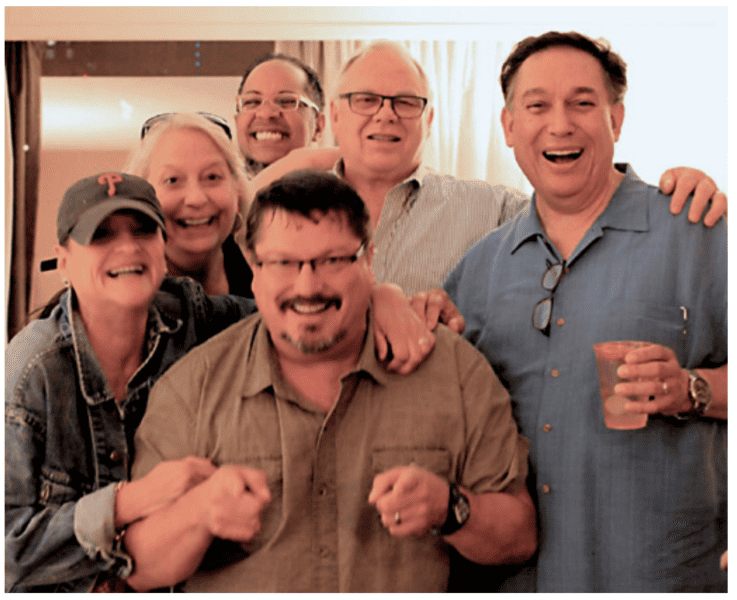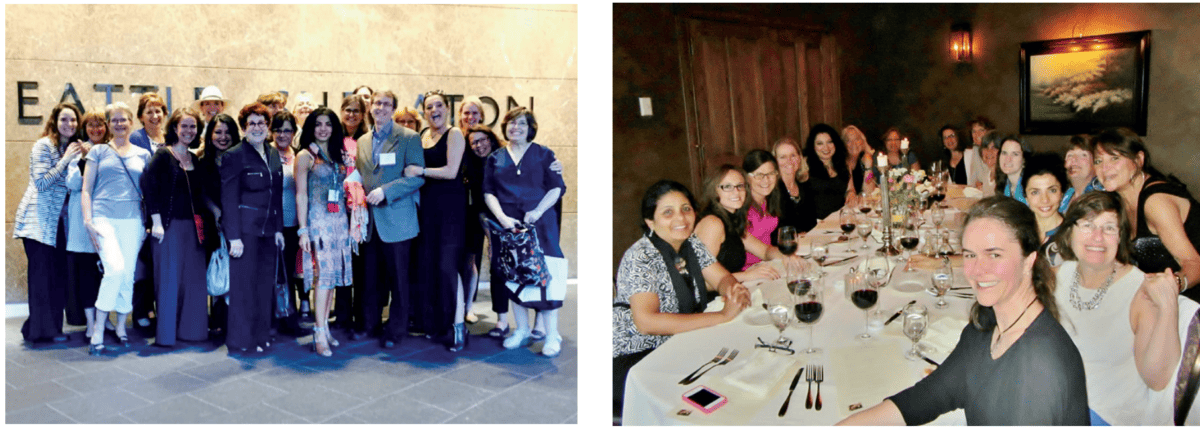Laura Sheppard, CDT, TE, one of the lab artists responsible for the success of dental sleep medicine, writes about the innovations she witnessed over her 4-decade career.

Continuing in our occasional series of talking to the founders of dental sleep medicine, this time I sat down with Laura Sheppard, one of the lab artists responsible ‘behind the scenes’ for DSM success. Here’s part of her story. A future issue will bring some critical tips from the laboratory professional.
Oral appliances to treat sleep or breathing disorders first appeared on my radar in the 1980’s. At the time, I was a lab technician specializing in TMJ & orthodontic appliances and working for Dental Services Group laboratories. This is when we first began to receive inquiries for palatal lifter appliances. This device resembled a maxillary orthodontic retainer with a small adjustable paddle-like extension. The paddle was designed to extend past the palatine bones, and its purpose was to hold up the soft tissue and keep the airway open for patients with muscular issues such as palatopharyngeal incompetence. These were worn full time, not just during sleep. Then, we started getting requests for tongue retaining devices. In 1982, there had been a compelling study conducted by Drs. R.D. Cartwright and C.F. Samelson regarding the importance of getting the relaxed tongue out of the airway during sleep. But for most people experiencing sleep and snoring problems, the standard non-surgical solutions were relegated to body positioning devices, chin straps, nose plugs, earplugs or sleeping alone.

Toward the end of the 80s with more awareness came more appliances being introduced to open the airway during sleep. Great Lakes Orthodontic Lab introduced the Tepper Oral Proprioceptive Stimulator (TOPS), invented by Dr. Harry Tepper. This device was worn on the upper arch and had a spring-activated flipper to stimulate the tongue during sleep. Then came the Snore Guard. Such a great name. To this day, many patients and practitioners still call a sleep appliance a ‘Snore Guard’. The actual Snore Guard was invented by Dr. Thomas Meade. It was a single piece (fused monoblock) boil-n-bite. It was an upper and lower mouthpiece that covered the anterior teeth. It was designed to keep the jaws end-to-end and mouth closed during sleep. Dr. Meade developed this concept by building from Dr. Wolfgang Schmidt-Nowara’s findings concerning the therapeutic airway benefit of mandibular repositioning and corresponding tongue positioning. This appliance would theoretically replace surgery by moving the mandible forward, thus advance the tongue out of the airway. Dr. Meade laid one of the first critical steppingstones for our appliance journey. For me, together with my early growth and development training, this ‘airway thread’ just kept growing in length and width.

While the Snore Guard was a great concept, the design was fraught with side effects. The ‘end-to-end’ positioning did not work for all patients. And patients’ anterior teeth became sensitive. We noticed that anterior bites were opening due to hyper-eruption of uncovered posteriors. The boil-n-bite process and material itself were not ideal. Around this time, I received a call from John Tregillis, a dear technician friend from our partner laboratory in MN. He wanted me to get in touch with Dr. Jonathon Parker. Dr. Parker would become my mentor and dear friend. He would also become one of the finest educators in dental sleep medicine, teaching and mentoring countless successful practitioners in the field today. Dr. Parker was a TMJ specialist looking for technical support in developing a ‘Snore Guard-type’ device that was ‘custom-fit’ and full coverage. This became the PM Positioner. It solved several of the identified issues, but still was not an ideal design. Concurrently, Dr. Peter George, an orthodontist, introduced a similar custom made, fused mandibular repositioner called the Nocturnal Airway Patency Appliance (NAPA).
By this time, dentists started realizing a dual challenge. Every patient was different, possessing their own optimum therapeutic position. ‘How to measure and capture the bite?’ And, ‘How to adjust an appliance to test it – to the point of optimum?’ Dr. George went to work on the bite registration issue right away, inventing the George Gauge, the first bite registration tool to measure and capture protrusive positioning. Since these fused appliances could not be adjusted to the patient’s best position, the concept of the ‘trial’ appliance was developed. Trial appliances became a standard preliminary step to finding the optimal mandibular position, before manufacturing a final fused appliance.

The 1990’s ushered in adjustable appliances. Everything changed when Great Lakes Orthodontic Lab introduced the Klearway appliance invented by Dr. Alan Lowe, Professor and Chair of Orthodontics at the University of British Columbia, Vancouver, Canada. His design was the first custom-fit, upper and lower appliance that was not fused together. And it offered incremental adjustability for mandibular titration! I was thrilled, a valid treatment appliance made with orthodontic parts and mechanisms. This device was speaking my language.
Dr. Parker had prescribed many Klearway devices, and while treatment results were vastly improved, the appliance had some design related issues. The advancement screw was a Hyrax RPE screw turned laterally, which was rather large in the palatal space, and its long extended arms to the mandibular portion would adversely bend with patients’ functional forces. This resulted in a weak, fracture-prone area. So, together we came up with various design options to remedy these faults and created Dr. Parker’s Adjustable PM Positioner (APM). The APM utilized buccal advancement screws to avoid encroaching on the tongue space or the palate, but its fault was its limited lateral freedom.

Great Lakes Orthodontic Lab began to re-purpose the Herbst appliance as a sleep appliance. The Herbst had a long history of orthodontic mandibular repositioning for Class II patients to encourage condylar growth in adolescents. The Herbst arms were also buccally placed, but offered more lateral freedom. The Herbst flaws were related to wire framework fractures. In 1994, Dr. Keith Thornton, a TMJ and restorative dentist in TX, developed the Thornton Adjustable Positioner (TAP). The TAP appliance had a threaded adjustable hook placed on the upper midline positioned to engage a lower anterior bar. These main 4 adjustable appliances were demonstrating great results by being able to titrate to the optimal position for each patient.
Meanwhile, as we were each exploring our way into dental sleep therapy, a powerful nucleus of momentum was forming. A small motivated group of esteemed practitioners from across North America, equally passionate about the untreated sleep-deprived patient, started a study club which led to the formation of the Sleep Disorders Dental Society (SDDS) in 1992. Arthur Strauss, DDS; Peter George, DDS; Alan Lowe, DMD, PhD; Michael Alvarez, DDS; Gary Johnson, DDS; Jeffery Hall, DDS; and Don Rosenbloom, DDS were all committed to learning and experiencing as much about sleep and breathing as possible. The SDDS would become the AADSM in 2006.
Attending my first SDDS meeting blew my mind! It was a pivotal point in my life. It was such a privilege to meet and engage with the founding doctors and the attendees. Mind you, it was a very small group at the time, no more than 50 people. But from the first, and until now, the AADSM doctors have always been the most receptive, open, curious, and caring group of physicians I have ever had the pleasure to work with. This is also where I first met my dear friend Christina LaJoie from Great Lakes Orthodontics Lab. I had met my tribe and gained a purpose.

The SDDS knew that it would be a long uphill battle to gain knowledge and credibility, and to provide awareness, resources, and education to interested treatment professionals everywhere. In the process, their challenges would come from all sides: the dental status quo, the medical community, public media, insurance companies, and the FDA. And dental laboratories and inventors would be challenged with continually improving appliance design. Every year the SDDS would come together, and we would share new research, developments, successes and realizations that would continue to raise the standard of care.
For example, by the mid-90s, there was no doubt that mandibular repositioning was working well. But in the process of conducting follow-up with their successful patients, Dr. Parker and his colleagues became aware of an irreversible side effect happening. Bites were changing. I remember the CEO of my laboratory company wore an APM Positioner for 3 years and we noticed he had a Class III bite that we had not seen before. When I voiced my concern that this may be from wearing the sleep appliance, he defensively stated “I’m not worried about my bite change, just don’t take away my appliance!” He felt his appliance helped him so much that it was worth sacrificing his normal occlusion. And he had been a dental lab guy all his life! As much as we were enjoying the success of mandibular repositioning, it was becoming more and more evident that these appliances were changing bites and occlusions. That’s when the concept of the morning aligner was developed. With a good morning exercise routine, the bite changes could be minimized. Going forward, the morning alignment routine became a standard of care recommendation.
Filling the need for improved treatment has always been my goal. For me, I am always looking for a better treatment design and improved materials. Thankfully, our 40 year evolution in device design has not disappointed. I have had the opportunity to work with many labs, inventors and designers to improve appliance design and manufacture. I’ve assisted in the development of successful patented devices and have provided guidance in understanding and implementing the requirements involved in FDA compliance and regulatory standards.
As for Christina and myself, it was as if we were two lighthouses, lighting and guiding our doctors’ journeys. And we reveled in their success. Through the years, many doctors would come to rely on us. Our labs promoted and sponsored many courses, presented at universities, and provided support materials, training assistance and demo appliances. Together, Christina and I have made this our mission for 40+ years. As was the nature of this group, personal competition was not in our purview. United and committed, we both knew the importance of this emerging field and respected each other’s different skill sets. Christina and I had the pleasure of working with, and coaching hundreds of doctors to start and succeed in practicing DSM. We even started the Lady Sleep Docs group, where most of our ladies became full-time practitioners and mentors, and many were elected to the highest leadership positions within the AADSM. And, we truly loved entertaining our doctors! We had so many good times and made a lot of great memories!
So much for my trip down memory lane. Next issue, I’m going to pass along some clinical/lab tips from these four decades I’ve enjoyed working with all of you.
Check out this article by Laura Sheppard, CDT, TE, that delves into a CAD/CAM milled Obstructive Sleep Apnea device. https://dentalsleeppractice.com/microdental-introduces-micro2/



